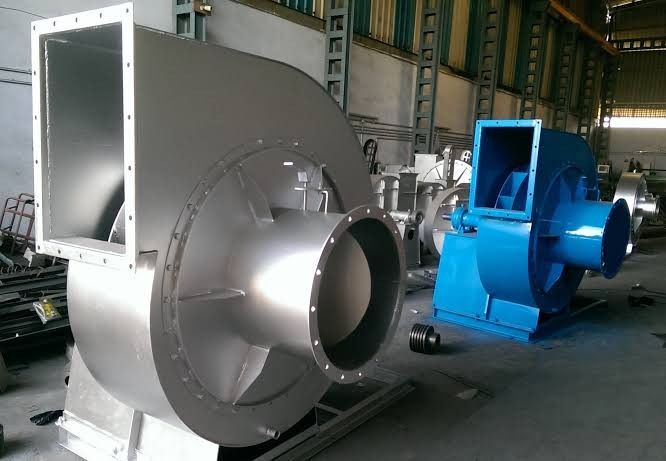An industrial blower is a mechanical device designed to move large volumes of air or gas through ventilation systems, ducts, or processing areas. These machines are essential in industries that require controlled air movement for cooling, drying, dust control, and material handling.
The concept of industrial blowers emerged during the industrial revolution when manufacturing processes began to demand consistent airflow for combustion, ventilation, and temperature regulation. Modern blowers use electric motors or turbines to generate high airflow with improved energy efficiency.

Importance – Why Industrial Blowers Matter Today
Industrial blowers are a core component in manufacturing, construction, mining, and energy sectors.
-
For Manufacturing – Maintain clean air, regulate temperature, and improve worker safety.
-
For Energy & Power Plants – Support combustion processes in boilers and furnaces.
-
For Environmental Compliance – Reduce airborne contaminants to meet health standards.
-
For Operational Efficiency – Provide continuous airflow for cooling and drying operations.
| Industry | Application of Blowers |
|---|---|
| Cement Manufacturing | Cooling rotary kilns and transporting materials |
| Food Processing | Drying, ventilation, and product cooling |
| Mining | Removing dust and supplying fresh air |
| Chemical Plants | Ventilation and hazardous gas handling |
Recent Updates – Trends and Developments in Industrial Blowers
In the past year, there have been significant improvements in blower technology:
-
Energy-Efficient Designs – New models use variable frequency drives (VFDs) to reduce power consumption.
-
Low-Noise Technology – Manufacturers are incorporating advanced silencers to meet workplace noise regulations.
-
Smart Monitoring Systems – IoT-enabled blowers now allow real-time performance tracking and predictive maintenance.
-
Material Innovation – The use of corrosion-resistant alloys for longer equipment life, especially in chemical industries.
A 2024 market report from GlobalData projects a steady growth rate for the industrial blower market due to rising environmental regulations and automation trends.
Laws or Policies – Regulatory Considerations for Industrial Blowers
Regulations surrounding industrial blowers vary by country but generally focus on energy efficiency, emissions, and worker safety:
-
OSHA Standards (USA) – Requires adequate ventilation to maintain safe indoor air quality.
-
European Union Ecodesign Directive – Sets energy efficiency requirements for industrial fans and blowers.
-
Indian Pollution Control Board Guidelines – Regulate air quality and emissions in industrial operations.
-
ISO 5801 – International standard for performance testing of fans and blowers.
Compliance not only ensures safety but can also lead to operational cost savings through more efficient systems.
Tools and Resources – Helpful Solutions for Industrial Blower Selection and Maintenance
-
Centrifugal and Axial Fan Selection Software – Helps engineers choose the right blower type based on airflow and pressure needs.
-
Energy Consumption Calculators – Available online to estimate operating costs.
-
IoT Monitoring Platforms – Such as Siemens MindSphere for predictive maintenance.
-
Maintenance Checklists – Downloadable templates for routine inspections.
-
Manufacturer Catalogues – Detailed specifications for capacity, efficiency, and dimensions.
FAQs – Common Questions About Industrial Blowers
Q1: What is the difference between a centrifugal blower and an axial blower?
Centrifugal blowers push air outward through a fan wheel, making them ideal for high-pressure needs, while axial blowers move air parallel to the shaft, suitable for high airflow and low-pressure applications.
Q2: How do I determine the right blower size for my application?
Sizing depends on airflow requirements (CFM), static pressure, and environmental conditions. Consulting manufacturer charts or using selection software is recommended.
Q3: Are industrial blowers energy-intensive?
They can be, but modern blowers with variable speed drives and efficient impeller designs consume significantly less energy.
Q4: How often should an industrial blower be serviced?
Routine inspections are advised every three months, with complete servicing annually to maintain peak performance.
Q5: Can blowers handle hazardous gases?
Yes, specialized blowers are designed with corrosion-resistant materials and explosion-proof motors for handling hazardous or flammable gases.
Final Thoughts
Industrial blowers are critical to the safe and efficient operation of many industries. From controlling air quality to supporting manufacturing processes, they are integral to productivity and compliance. As technology advances, newer models offer better efficiency, lower noise, and smarter monitoring capabilities—making them an even more valuable asset in industrial operations.
